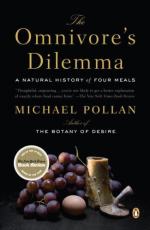
|
| Name: _________________________ | Period: ___________________ |
This test consists of 5 multiple choice questions, 5 short answer questions, and 10 short essay questions.
Multiple Choice Questions
1. The increased ______ of corn has meant a drop in crop space for other plants, according to Naylor.
(a) Mutation.
(b) Use.
(c) Planting.
(d) Production.
2. What is the name of the once trash strewn park that was turned into a community garden?
(a) Garden Park.
(b) Berkeley Park.
(c) Roller Park.
(d) People's Park.
3. Salatin uses the animals to create a _________ system that also bolsters efficiency on the farm.
(a) Embryonic.
(b) Probiotic.
(c) Symbiotic.
(d) Pastoral.
4. The factories from the war time began to produce ________ for farmers to help with their crops.
(a) Fertilizers.
(b) GMOs.
(c) Organic blends.
(d) Wheat.
5. Humans are not a perfect natural system in the food system because they can only _______ so much food.
(a) Throw away.
(b) Consume.
(c) Buy.
(d) Make.
Short Answer Questions
1. In what part of the body can one determine just how much corn is being eaten by the person?
2. A new program was introduced to pay the farmers directly for the difference in price between the target and the selling price of ________.
3. Salatin points out that being ________ doesn't necessarily mean that a farm is also going to be sustainable.
4. Pollan learns that most organic _______ comes from factory farms, even though they seem to be "better."
5. The invention of synthetic materials also meant that _________ would become necessary to fix the nitrogen.
Short Essay Questions
1. What did Pollan feel about the meal that he had that was made from all organic foods?
2. What is the main idea behind the process of grass farming?
3. Why does most of the corn planting farming rely on the use of genetically modified organisms (GMO)?
4. What happened as a result of corn having mutated early on in its use?
5. What does Pollan point out as being the ingredients that are in a common breakfast cereal?
6. What does Pollan point out as a downside of there being more organic farms around today?
7. What does Pollan note as being a problem with organic foods being labeled as organic, as shown in the example of the lettuce?
8. What are three of the benefits to grass farming, as outlined by Pollan?
9. What is corn starch broken down into after it has been processed in the wet milling process?
10. What does Pollan point out is the start of any of the foods in the food chain, which came as a surprise to him?
|
This section contains 609 words (approx. 3 pages at 300 words per page) |

|




